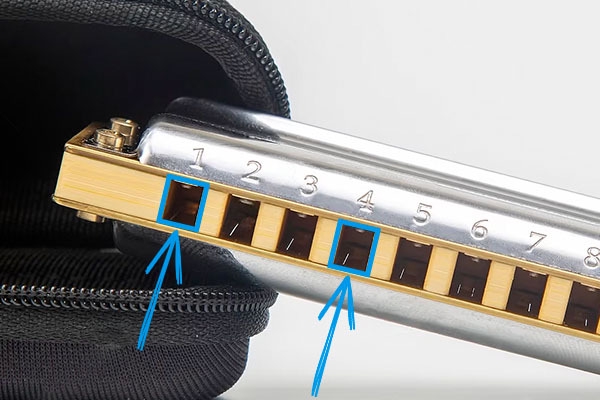When I first learned this technique I was SO EXCITED about the BIG sound, and today still I use this technique ALL THE TIME.
What is it? ![]()
It’s the technique used to play 2 holes that are NOT next to each otherat the same time.
This is achieved by using the tongue to block the holes in between the 2 holes being played.
Of all the splits available, by far Split-4’s are the most commonly playedsplits, and they are often referred to as “Octaves” because many (though not all) of the split-4’s produce the interval of an octave.
A Split-4 means your mouth is covering 4 holes, your tongue is blocking the 2 holes in the middle.
By contrast, with a Split-3 your tongue would only be blocking 1 hole.
And a Split-5 your tongue would be blocking 3 holes.
A Split-6, the tongue blocks 4 holes, and so on, covering as many holes as the width of your mouth will allow.
![]() (Side-Note: I perceive these other kinds of splits (3,5,6) to be incredibly underutilized in the world of harmonica, and represent an exciting area for exploration and growth of the instrument.)
(Side-Note: I perceive these other kinds of splits (3,5,6) to be incredibly underutilized in the world of harmonica, and represent an exciting area for exploration and growth of the instrument.)
Why should you care? ![]()
Check out this video.
This is a HUGE SOUND ![]() that adds a POWERFUL tool to your sonic tool belt, and it’s incredibly useful for:
that adds a POWERFUL tool to your sonic tool belt, and it’s incredibly useful for:
![]() Bluesifying your playing
Bluesifying your playing
![]() Building intensity / creating climax in a solo
Building intensity / creating climax in a solo
![]() Backing up another soloist in a jump chorus horn section style
Backing up another soloist in a jump chorus horn section style
![]() Playing a nice fat sound implying the V Chord in 2nd position blues
Playing a nice fat sound implying the V Chord in 2nd position blues
And that’s just to name a FEW of the reasons. ![]() I go through all of this stuff in my Beginner to Boss course in Module 5, by the way.
I go through all of this stuff in my Beginner to Boss course in Module 5, by the way.
How do you do it? ![]()
The easiest place to learn to do your first split-4 is on holes 1 and 4(because there are no holes to the left of hole 1).
![]() Play the whole chord.
Play the whole chord.
![]() Cover holes 2 and 3 with your tongue so you’re just playing 14 and -14.
Cover holes 2 and 3 with your tongue so you’re just playing 14 and -14.
I learned using the tip of my tongue, but a more ideal technique is to point the tongue down so that the tip of it is protruding just below the bottom of the hole. The tongue is FASCINATING and can move in a million different ways. So just PLAY with this.
If you’re struggling, here’s a couple more tips/resources:
![]() Cover the holes with tape to help you get the sound in your ears.
Cover the holes with tape to help you get the sound in your ears.
![]() Buy one of Joe Filisko’s Tongue Blocking Trainers, or make your ownso you can literally see what’s going on.
Buy one of Joe Filisko’s Tongue Blocking Trainers, or make your ownso you can literally see what’s going on.

